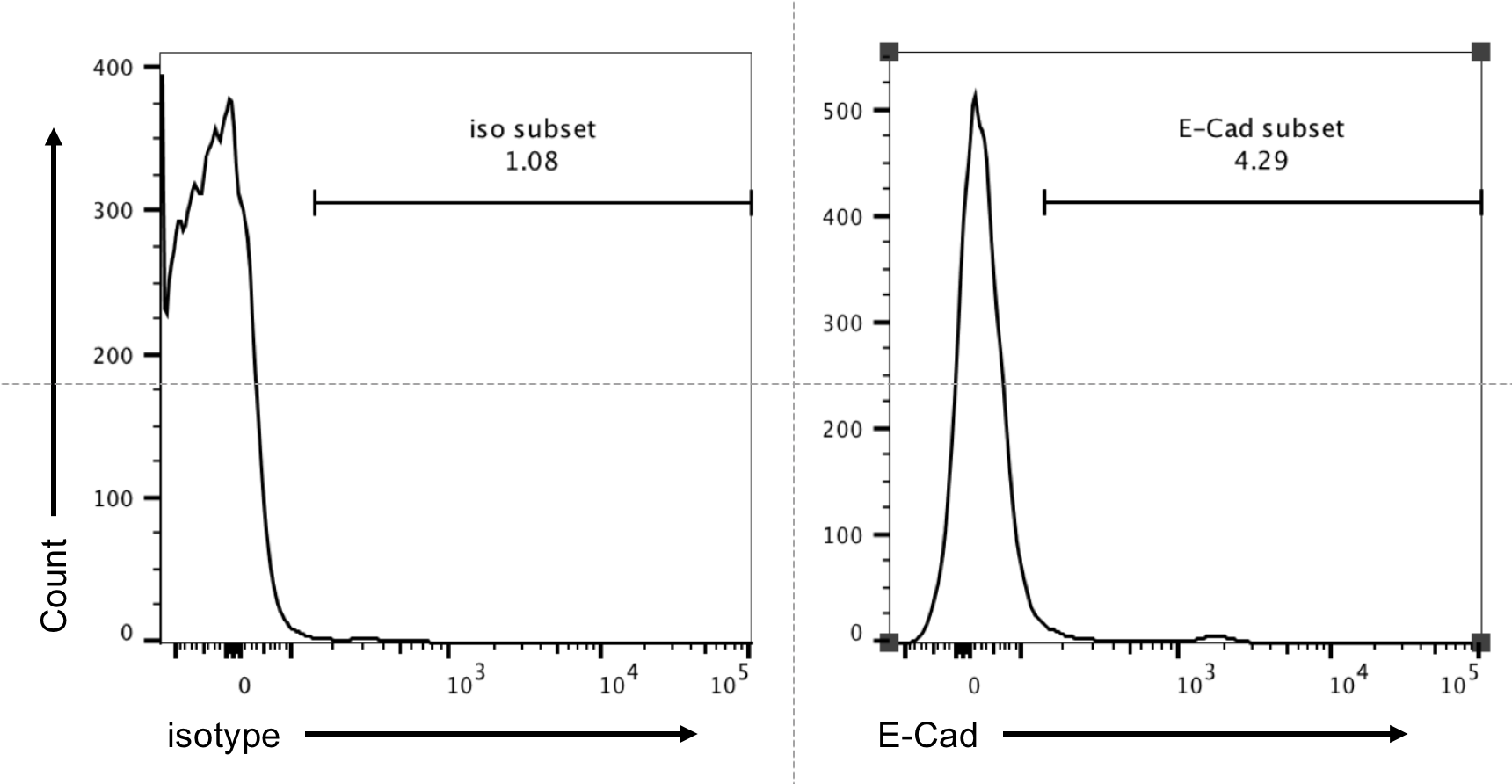Mouse E-Cadherin PE-conjugated Antibody Summary
Asp157-Val709 (predicted)
Accession # P09803
Applications
Please Note: Optimal dilutions should be determined by each laboratory for each application. General Protocols are available in the Technical Information section on our website.
Scientific Data
 View Larger
View Larger
Detection of E‑Cadherin in D3 Mouse Cell Line by Flow Cytometry. D3 mouse embryonic stem cell line was stained with Rat Anti-Mouse E-Cadherin PE-conjugated Monoclonal Antibody (Catalog # FAB7481P, filled histogram) or isotype control antibody (IC006P, open histogram). Cells were stained in a buffer containing Ca2+and Mg2+. View our protocol for Staining Membrane-associated Proteins.
 View Larger
View Larger
Detection of E‑Cadherin in mlMCD3 cells by Flow Cytometry. mlMCD3 cells were stained with Rat Anti-Mouse E‑Cadherin PE‑conjugated Monoclonal Antibody (Catalog # FAB7481P, filled histogram) or isotype control antibody (Catalog # IC006P, open histogram). View our protocol for Staining Membrane-associated Proteins.
Reconstitution Calculator
Preparation and Storage
- 12 months from date of receipt, 2 to 8 °C as supplied.
Background: E-Cadherin
Epithelial (E) - Cadherin (ECAD), also known as cell-CAM120/80 in the human, uvomorulin in the mouse, Arc-1 in the dog, and L-CAM in the chicken, is a member of the cadherin family of cell adhesion molecules. Cadherins are calcium-dependent transmembrane proteins, which bind to one another in a homophilic manner. On their cytoplasmic side, they associate with the three catenins, alpha, beta, and gamma (plakoglobin). This association links the cadherin protein to the cytoskeleton. Without association with the catenins, the cadherins are non-adhesive. Cadherins play a role in development, specifically in tissue formation. They may also help to maintain tissue architecture in the adult. E-Cadherin may also play a role in tumor development, as loss of E-Cadherin has been associated with tumor invasiveness. E-Cadherin is a classical cadherin molecule. Classical cadherins consist of a large extracellular domain which contains DXD and DXNDN repeats responsible for mediating calcium‑dependent adhesion, a single-pass transmembrane domain, and a short carboxy-terminal cytoplasmic domain responsible for interacting with the catenins. A soluble form of E-Cadherin can be released from epithelial cell surfaces by proteolysis. E‑Cadherin contains five extracellular calcium‑binding domains of approximately 110 amino acids each.
- Bussemakers, M.J.G. et al. (1993) Mol. Biol. Reports 17:123.
- Overduin, M. et al. (1995) Science 267:386.
- Takeichi, M. (1991) 251:1451.
Product Datasheets
Citations for Mouse E-Cadherin PE-conjugated Antibody
R&D Systems personnel manually curate a database that contains references using R&D Systems products. The data collected includes not only links to publications in PubMed, but also provides information about sample types, species, and experimental conditions.
5
Citations: Showing 1 - 5
Filter your results:
Filter by:
-
Noncatalytic PTEN missense mutation predisposes to organ-selective cancer development in vivo.
Authors: Caserta E, Egriboz O, Wang H et al.
Genes Dev.
-
M1-Polarized Macrophages Promote Self-Renewing Phenotype of Hepatic Progenitor Cells with Jagged1-Notch Signalling Involved: Relevance in Primary Sclerosing Cholangitis
Authors: H Li, S Sun, Q Lei, P Lei, X Cai, C Wan, G Shen
J Immunol Res, 2018-12-24;2018(0):4807145.
Species: Mouse
Sample Types: Whole Cells
Applications: Flow Cytometry -
A Transcriptional switch point during hematopoietic stem and progenitor cell ontogeny
Stem Cells Dev., 2017-01-24;0(0):.
Species: Mouse
Sample Types: Whole Cells
Applications: Flow Cytometry -
Adenovirus-mediated intratumoral expression of immunostimulatory proteins in combination with systemic Treg inactivation induces tumor-destructive immune responses in mouse models.
Authors: Liu Y, Tuve S, Persson J, Beyer I, Yumul R, Li ZY, Tragoolpua K, Hellstrom KE, Roffler S, Lieber A
Cancer Gene Ther., 2011-03-11;18(6):407-18.
Species: Mouse
Sample Types: Whole Cells
Applications: Flow Cytometry -
Isolation and Properties of an In Vitro Human Outer Blood-Retinal Barrier Model
Authors: Robin D. Hamilton, Lopa Leach
Methods in Molecular Biology
FAQs
No product specific FAQs exist for this product, however you may
View all Antibody FAQsReviews for Mouse E-Cadherin PE-conjugated Antibody
Average Rating: 5 (Based on 1 Review)
Have you used Mouse E-Cadherin PE-conjugated Antibody?
Submit a review and receive an Amazon gift card.
$25/€18/£15/$25CAN/¥75 Yuan/¥2500 Yen for a review with an image
$10/€7/£6/$10 CAD/¥70 Yuan/¥1110 Yen for a review without an image
Filter by:
Cells were pre-gated with live/dead and FSC-A/W to exclude dead cells and cell doublets.
The single cell suspension was isolated from lung of WT B6 mouse and stained with the E-Cadherin PE-conjugated antibody(1:100) for 30 minutes. Cells were analyzed by flow cytometer.



